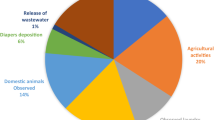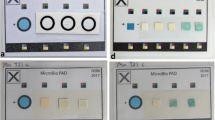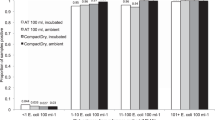Abstract
The addition of human and animal excreta in drinking water causes biological contamination leading to serious health issues for consumers, especially in develo** countries. The hydrogen sulphide (H2S) paper-strip test is an inexpensive method for the detection of faecal contamination in water. This test is simple and easy to use and is widely used in develo** countries like India for routine testing. This study was intended at evaluating the performance of the H2S test method for the reliable detection of faecal coliforms in drinking water. The performance was assessed by matching its output against established tests used for the quantitative evaluation of faecal coliforms in drinking water. The Colilert-18 test and traditional spread plate method were used to compare the findings of 102 water samples that were examined using the H2S test kit. The coliform detection limit of the H2S kit was observed as 30.0 MPN/100 ml when incubated at 35 °C and requires up to 36 h of incubation time. The H2S kit’s sensitivity and specificity were found to be 61.76% and 70.59%, respectively, indicating that it is an unsuitable test for detecting microbial contamination. The study suggests that there is an urgent need for the development of better alternatives.
Similar content being viewed by others
References
World Health Organization (2019) Water, sanitation, hygiene and health: a primer for health professionals. World Health Organization, Geneva (WHO/CED/PHE/WSH/19.149). Accessed 1 June 2021. https://apps.who.int/iris/bitstream/handle/10665/330100/WHO-CED-PHE-WSH-19.149-eng.pdf
Shayo GM, Elimbinzi E, Shao GN, Fabian C (2023) Severity of waterborne diseases in develo** countries and the effectiveness of ceramic filters for improving water quality. Bull Natl Res Cent 47:113. https://doi.org/10.1186/s42269-023-01088-9
Bain R, Cronk R, Wright J, Yang H, Slaymaker T, Bartram J (2014) Fecal contamination of drinking-water in low-and middle-income countries: a systematic review and meta-analysis. PLoS Med 11:e1001644. https://doi.org/10.1371/journal.pmed.1001644
Holcomb DA, Stewart JR (2020) Microbial indicators of fecal pollution: recent progress and challenges in assessing water quality. Curr Envir Health Rpt 7:311–324. https://doi.org/10.1007/s40572-020-00278-1
Ananth M, Rajesh R, Amjith R, Arthi AL, Valamparampil MJ, Harikrishnan M, Resmi MS, Sreekanth KB, Sara V, Sethulekshmi S, Prasannakumar V, Deepthi SK, Jemin AJ, Krishna DS, Anish TS, Insija IS, Nujum ZT (2018) Contamination of household open wells in an urban area of Trivandrum, Kerala State, India: a spatial analysis of health risk using geographic information system. Environ Health Insights 12:1–9
Lakshminarayanan S, Jayalakshmy R (2015) Diarrheal diseases among children in India: current scenario and future perspectives. J Nat Sci Biol Med 6:24–28
World Health Organization, UNICEF (2014) Progress on sanitation and drinking water-2014 update. World Health Organization Press, Geneva
Federation WE, Aph Association (2005) Standard methods for the examination of water and wastewater. American Public Health Association (APHA), Washington
McFETERS GA, Cameron SC, LeChevallier MW (1982) Influence of diluents, media, and membrane filters on detection of injured waterborne coliform bacteria. Appl Environ Microbiol 43:97–103. https://doi.org/10.1128/aem.43.1.97-103.1982
LeChevallier MW, Cameron SC, McFETERS GA (1983) New medium for improved recovery of coliform bacteria from drinking water. Appl Environ Microbiol 45:484–492. https://doi.org/10.1128/aem.45.2.484-492.1983
Clark JA (1968) A presence–absence (P–A) test providing sensitive and inexpensive detection of coliforms, fecal coliforms, and fecal streptococci in municipal drinking water supplies. Can J Microbiol 14:13–18. https://doi.org/10.1139/m68-003
Allen MJ, Geldreich EE (1975) Bacteriological criteria for ground-water quality a. Groundwater 13:45–52. https://doi.org/10.1111/j.1745-6584.1975.tb03064.x
Manja KS, Maurya MS, Rao KM (1982) A simple field test for the detection of faecal pollution in drinking water. Bull World Health Organ 60:797–801
World Health Organization (2002) Evaluation of the H2S method for detection of fecal contamination of drinking water. World Health Organization, Geneva
Mosley L, Sharp DS (2005) The hydrogen sulphide (H2S) paper-strip test: a simple test for monitoring drinking water quality in the Pacific Islands. South Pacific Applied Geoscience Commission (SOPAC) Technical Report 373, Suva, Fiji
Matwewe F, Hyland K, Thomas J (2018) Locally produced hydrogen sulphide detecting water quality test kits increase household level monitoring in rural Tanzania. J Water Health 16:359–368. https://doi.org/10.2166/wh.2018.220
Ministry of Jal Shakti, Department of Drinking Water and Sanitation, National Jal Jeevan Mission (2021) Drinking water quality monitoring and surveillance framework. Ministry of Jal Shakti, Government of India, New Delhi
HiMedia (2009) Himedia’s multi-parameter water testing systems, AquaLab: complete solution to water testing. HiMedia Laboratories Pvt. Limited, Mumbai
Niemela SI, Lee JV, Fricker CR (2003) A comparison of the International Standards Organisation reference method for the detection of coliforms and Escherichia coli in water with a defined substrate procedure. J Appl Microbiol 95:1285–1292. https://doi.org/10.1046/j.1365-2672.2003.02099.x
US Environmental Protection Agency (2003) guidelines establishing test procedures for the analysis of pollutants; analytical methods for biological pollutants in ambient water. Final rule. U.S. Federal Register—40 CFR Part 136 Vol. 68 (139)
Tambi A, Brighu U, Gupta AB (2020) MColiPAT kit for early detection of coliforms in water. Water Supply 20:871–877. https://doi.org/10.2166/ws.2020.008
Pillai J, Mathew K, Gibbs R, Ho GE (1999) H2S paper strip method—A bacteriological test for faecal coliforms in drinking water at various temperatures. Water Sci Technol 40:85–90. https://doi.org/10.1016/S0273-1223(99)00434-5
Kumar D, Tyagi N, Gupta AB (2012) Sensitivity analysis of field test kits for rapid assessment of the bacteriological quality of water. J Water Supply Res Trans 61:283–290. https://doi.org/10.2166/aqua.2012.088
Bain RE, Woodall C, Elliott J, Arnold BF, Tung R, Morley R, du Preez M, Bartram JK, Davis AP, Gundry SW, Pedley S (2015) Evaluation of an inexpensive growth medium for direct detection of Escherichia coli in temperate and subtropical waters. PLoS ONE 10:e0140997. https://doi.org/10.1371/journal.pone.0140997
Nair J, Gibbs R, Mathew K, Ho GE (2001) Suitability of the H2S method for testing untreated and chlorinated water supplies. Water Sci Technol 44:119–126. https://doi.org/10.2166/wst.2001.0354
Acknowledgements
This work was supported by the Water and Sanitation Support Organization (WSSO), PHED, Jaipur, Government of Rajasthan, India (Sanction No. WSSO/WQ/2016-2017/ 4794, dated 16.01.2017).
Author information
Authors and Affiliations
Corresponding author
Ethics declarations
Conflict of interest
The authors declare that they have no conflict of interest.
Additional information
Publisher's Note
Springer Nature remains neutral with regard to jurisdictional claims in published maps and institutional affiliations.
Significance Statement The H2S test kit is currently in use in many parts of the world, especially in develo** countries like India for the detection of faecal coliforms in drinking water samples. It is the commonly used for assessing microbial contamination and therefore, it is essential to assess the suitability of the H2S test kit in terms of limit and time of detection, sensitivity and specificity of the kit.
Rights and permissions
Springer Nature or its licensor (e.g. a society or other partner) holds exclusive rights to this article under a publishing agreement with the author(s) or other rightsholder(s); author self-archiving of the accepted manuscript version of this article is solely governed by the terms of such publishing agreement and applicable law.
About this article
Cite this article
Tambi, A., Brighu, U. & Gupta, A.B. Assessment of Reliability of H2S Strip Test for the Screening of Drinking Water Samples for Faecal Contamination. Proc. Natl. Acad. Sci., India, Sect. B Biol. Sci. 94, 407–412 (2024). https://doi.org/10.1007/s40011-023-01544-6
Received:
Revised:
Accepted:
Published:
Issue Date:
DOI: https://doi.org/10.1007/s40011-023-01544-6




